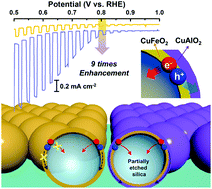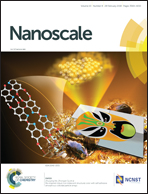Photoelectrodes based on 2D opals assembled from Cu-delafossite double-shelled microspheres for an enhanced photoelectrochemical response†
Abstract
Although a unique light-harvesting property was recently demonstrated in a photocathode based on 2-dimensional (2D) opals of CuFeO2-shelled SiO2 microspheres, the performance of a monolayer of ultra-thin CuFeO2-shelled microspheres is limited by ineffective charge separation. Herein, we propose an innovative design rule, in which an inner CuFeO2/outer CuAlO2 double-shelled heterojunction is formed on each partially etched microsphere to obtain a hexagonally assembled 2D opal photoelectrode. Our Cu-delafossite double-shelled photocathode shows a dramatically improved charge separation capability, with a 9-fold increase in the photocurrent compared to that of the single-shelled counterpart. Electrochemical impedance spectroscopy clearly confirms the reduced charge transport/transfer resistance associated with the Cu-delafossite double-shelled photocathode, while surface photovoltage spectra reveal enhanced polarization of the photogenerated carrier, indicating improved charge separation capability with the aid of the heterojunction. Our finding sheds light on the importance of heterojunction interfaces in achieving optimal charge separation in opal architectures as well as the inner-shell/electrolyte interface to expedite charge separation/transport.



 Please wait while we load your content...
Please wait while we load your content...